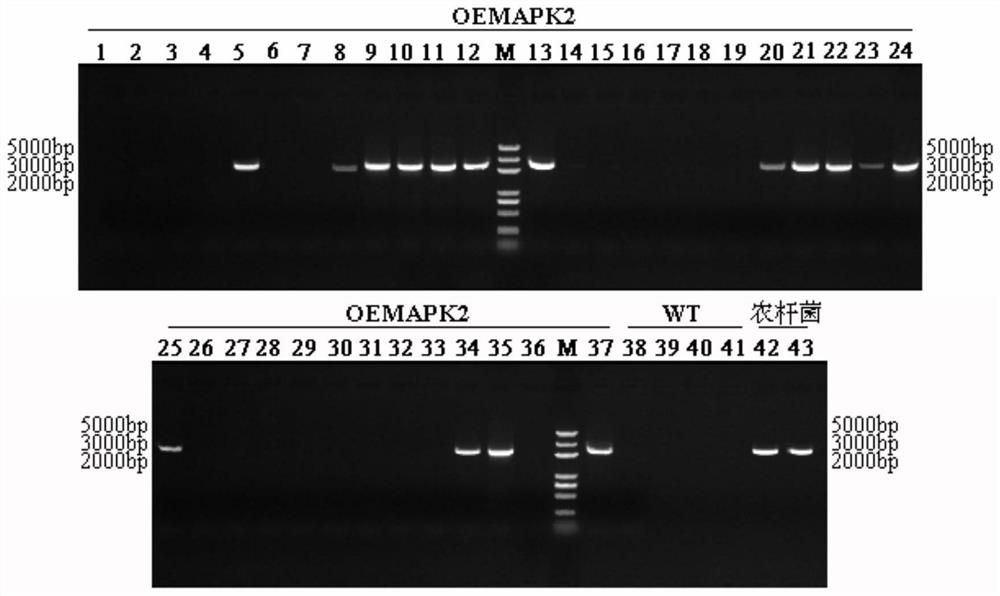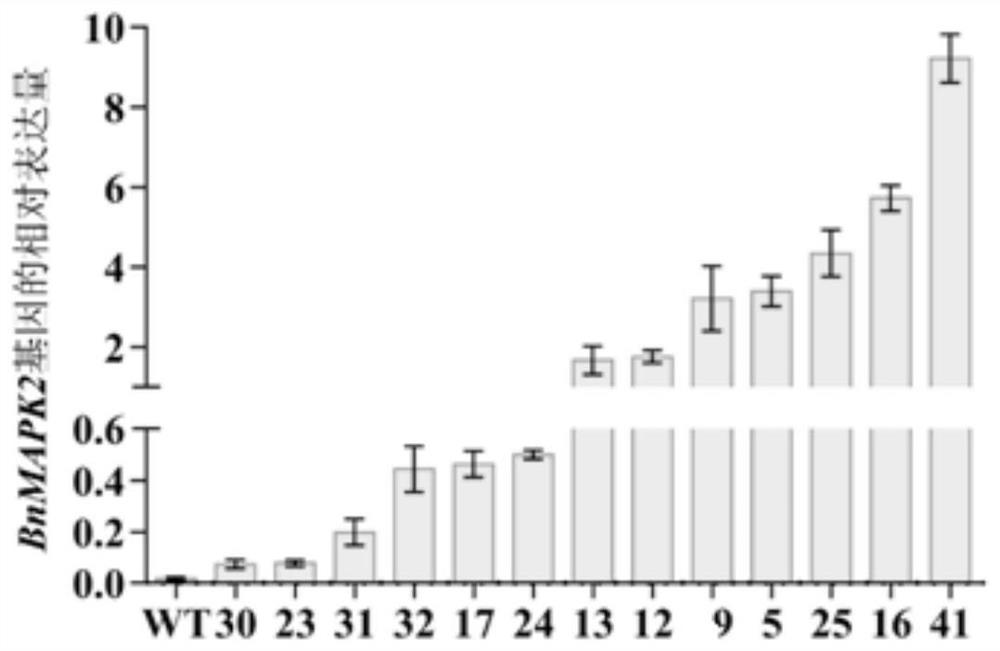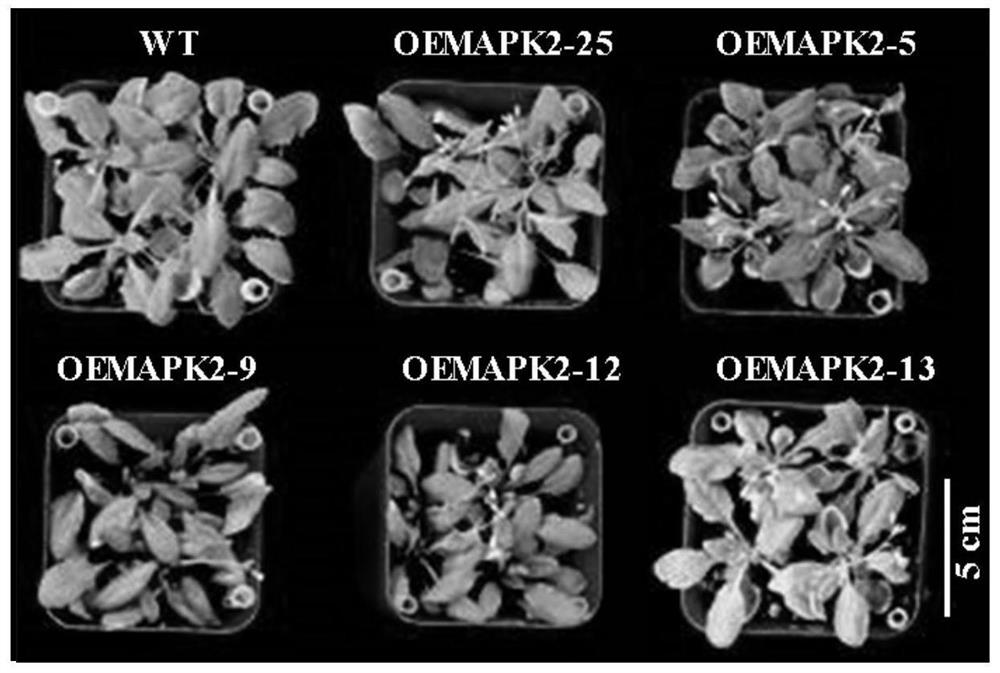Application and method of brassica napus BnMAPK2 gene
A Brassica napus, gene technology, applied in the directions of application, genetic engineering, plant genetic improvement, etc., can solve the problem that the effect has not yet been reported, and achieve the effect of improving tolerance
- Summary
- Abstract
- Description
- Claims
- Application Information
AI Technical Summary
Problems solved by technology
Method used
Image
Examples
Embodiment 1
[0028] Embodiment 1, BnMAPK2 overexpression vector construction
[0029] Using the known Arabidopsis AtMAPK2 gene sequence to search the Chinese cabbage genome database, predict the possible BnMAPK2 gene, and search the GenBank EST and GSS databases at the same time. The total RNA of mixed tissues and organs of Brassica napus Zhongyou 821 strain was extracted and cDNA was reverse transcribed, and the 5'RACE sequence and 3'RACE sequence of the target gene were synthesized by RECA method. RACE primers were designed according to the cDNA and EST sequences in the database, respectively using FMPK2-51 (SEQ ID NO.5)+RACE 5P (SEQ ID NO.7), FMPK2-52 (SEQ ID NO.6)+RACE 5P (SEQ ID NO.7), FMPK2-31 (SEQ ID NO.4)+RACE 3P (SEQ ID NO.9) (Table 1) primers for the first amplification, respectively to obtain FMPK2-51'R, FMPK2-52'R and FMPK2-31'R products. The PCR amplification conditions were: pre-denaturation at 94°C for 5 min → 35 amplification cycles (denaturation at 94°C for 30 s → anneal...
Embodiment 2
[0034] Example 2, Transformation of Arabidopsis wild-type plants and acquisition of Arabidopsis transgenic lines overexpressing BnMAPK2
[0035] After the recombinant vector was transformed into Agrobacterium, the wild-type Arabidopsis was transformed by the Agrobacterium carrying the recombinant vector pCAMBIA1300-BnMAPK2 by flower dipping method, cultured in the dark at 22°C for 24 hours, and Arabidopsis seedlings were taken out for routine culture. Single plant received T 0 generation seeds. T 1 Substituting seeds, extracting T 1 Genomic DNA of leaves of the first generation seedlings was used as a template, and a total of 16 plants ( figure 1 ). Plants detected as positive, harvested seeds T 2 After generations, the homozygous strains were screened using hygromycin-containing medium.
[0036] 13 of them were selected to extract young leaf RNA for PCR identification, and the qualified cDNA was obtained by reverse transcription method. With AtACT2 as the reference gene...
Embodiment 3
[0037] Example 3. Investigation of the agronomic traits of Arabidopsis transgenic lines overexpressing BnMAPK2
[0038] Referring to the seeding method of the Arabidopsis TAIR10 database operation manual, five Arabidopsis lines (OEMAPK2-25, OEMAPK2-5, OEMAPK2-9, OEMAPK2-12, OEMAPK2-13) and wild-type Arabidopsis overexpressed BnMAPK2 Mustard (WT) seeds were sterilized and sown on sterilized culture soil after vernalization. During the growth period, observe and record the growth and development of different transgenic Arabidopsis lines and wild-type Arabidopsis lines, including: emergence stage, four-leaf stage, eight-leaf stage, ten-leaf stage, bolting stage and stem length 5cm , 10cm, and 15cm dates, and take pictures of the bolting stage and mature plants for comparative analysis. When the Arabidopsis seeds are mature and harvested, count and record their agronomic traits, including: plant height, effective length of main inflorescence, number of pods of main inflorescence,...
PUM
 Login to View More
Login to View More Abstract
Description
Claims
Application Information
 Login to View More
Login to View More - R&D
- Intellectual Property
- Life Sciences
- Materials
- Tech Scout
- Unparalleled Data Quality
- Higher Quality Content
- 60% Fewer Hallucinations
Browse by: Latest US Patents, China's latest patents, Technical Efficacy Thesaurus, Application Domain, Technology Topic, Popular Technical Reports.
© 2025 PatSnap. All rights reserved.Legal|Privacy policy|Modern Slavery Act Transparency Statement|Sitemap|About US| Contact US: help@patsnap.com



